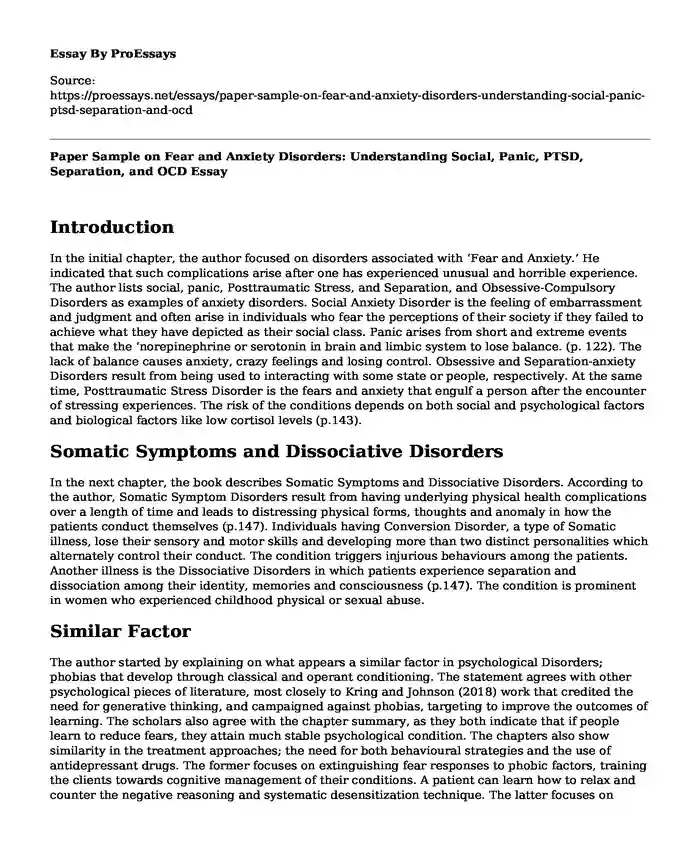Introduction
In the initial chapter, the author focused on disorders associated with ‘Fear and Anxiety.’ He indicated that such complications arise after one has experienced unusual and horrible experience. The author lists social, panic, Posttraumatic Stress, and Separation, and Obsessive-Compulsory Disorders as examples of anxiety disorders. Social Anxiety Disorder is the feeling of embarrassment and judgment and often arise in individuals who fear the perceptions of their society if they failed to achieve what they have depicted as their social class. Panic arises from short and extreme events that make the ‘norepinephrine or serotonin in brain and limbic system to lose balance. (p. 122). The lack of balance causes anxiety, crazy feelings and losing control. Obsessive and Separation-anxiety Disorders result from being used to interacting with some state or people, respectively. At the same time, Posttraumatic Stress Disorder is the fears and anxiety that engulf a person after the encounter of stressing experiences. The risk of the conditions depends on both social and psychological factors and biological factors like low cortisol levels (p.143).
Somatic Symptoms and Dissociative Disorders
In the next chapter, the book describes Somatic Symptoms and Dissociative Disorders. According to the author, Somatic Symptom Disorders result from having underlying physical health complications over a length of time and leads to distressing physical forms, thoughts and anomaly in how the patients conduct themselves (p.147). Individuals having Conversion Disorder, a type of Somatic illness, lose their sensory and motor skills and developing more than two distinct personalities which alternately control their conduct. The condition triggers injurious behaviours among the patients. Another illness is the Dissociative Disorders in which patients experience separation and dissociation among their identity, memories and consciousness (p.147). The condition is prominent in women who experienced childhood physical or sexual abuse.
Similar Factor
The author started by explaining on what appears a similar factor in psychological Disorders; phobias that develop through classical and operant conditioning. The statement agrees with other psychological pieces of literature, most closely to Kring and Johnson (2018) work that credited the need for generative thinking, and campaigned against phobias, targeting to improve the outcomes of learning. The scholars also agree with the chapter summary, as they both indicate that if people learn to reduce fears, they attain much stable psychological condition. The chapters also show similarity in the treatment approaches; the need for both behavioural strategies and the use of antidepressant drugs. The former focuses on extinguishing fear responses to phobic factors, training the clients towards cognitive management of their conditions. A patient can learn how to relax and counter the negative reasoning and systematic desensitization technique. The latter focuses on reduces hormonal stimulation. For instance, the use of antidepressants like benzodiazepines effectively reduces PTSD. Just like the work of Medalia et al. (2017) literature that charged the in-charge therapist with the role of establishing the type of disorder and applying the best cognitive or medicinal treatment, the mention of cognitive and antidepressants indicates an appreciation of the need for such professionals in managing psychological disorders.
Conclusion
The author exhaustively elaborated on the different disorders, providing the learner with broad information useful in handling such cases. The main score of the two chapters is their coincidence with other scholarly literature which insist on the integration of the cognitive and pharmacotherapy in managing psychological disorders. For instance, a good understanding of the work helps a learner to appreciate the need to initiate realistic perceptions and teaching patients with somatic symptoms to manage stress and shun beliefs of their vulnerability to illness. Apply the same approach in fear-related disorders would help care-givers to find the best method ever in treating the patients. The work also exhibited some weakness. In the current medical practice, clients will need proposals that clearly explain the approach to employ. The author did not distinctively guide on how one can choose between antidepressants or psychological methods, or even how one will know when a patient needs a switch to the other approach. Lack of such guide denies clients the chance to use the most appropriate treatment at specific moments.
References
Kring, A. M., & Johnson, S. L. (2018). Abnormal psychology: The science and treatment of psychological disorders. John Wiley & Sons.
Medalia, A., Herlands, T., Saperstein, A., & Revheim, N. (2017). Cognitive remediation for psychological disorders: therapist guide. Oxford University Press.
Cite this page
Paper Sample on Fear and Anxiety Disorders: Understanding Social, Panic, PTSD, Separation, and OCD. (2023, Oct 04). Retrieved from https://proessays.net/essays/paper-sample-on-fear-and-anxiety-disorders-understanding-social-panic-ptsd-separation-and-ocd
If you are the original author of this essay and no longer wish to have it published on the ProEssays website, please click below to request its removal:
- Freudian Theories in Works of Art
- Personal Beliefs on Family, Essay Example
- Essay Sample on Deviance and Social Norm
- Essay Sample on Target Behaviour Identification
- Jane Austen: The Role of Parenthood in Mansfield Park and Persuasion Paper Example
- Essay Example on Aging Stereotypes and Their Impact on Society: Jared Diamond's Argument
- Essay on Age-Related Deterioration: Understanding Aging Theories to Promote Quality Services for Older Adults







